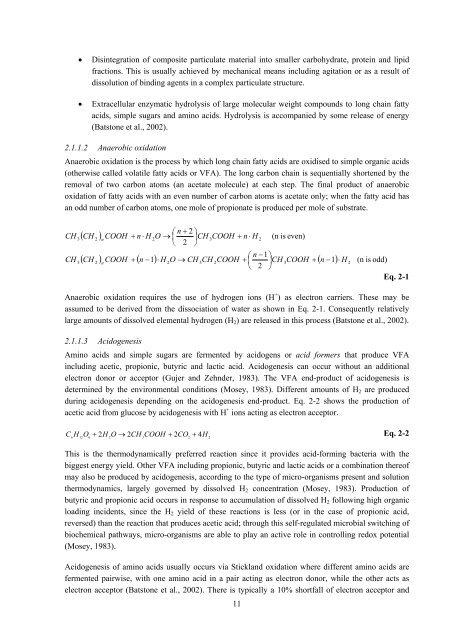analysis of a pilot-scale anaerobic baffled reactor treating domestic ...
analysis of a pilot-scale anaerobic baffled reactor treating domestic ...
analysis of a pilot-scale anaerobic baffled reactor treating domestic ...
Create successful ePaper yourself
Turn your PDF publications into a flip-book with our unique Google optimized e-Paper software.
• Disintegration <strong>of</strong> composite particulate material into smaller carbohydrate, protein and lipid<br />
fractions. This is usually achieved by mechanical means including agitation or as a result <strong>of</strong><br />
dissolution <strong>of</strong> binding agents in a complex particulate structure.<br />
• Extracellular enzymatic hydrolysis <strong>of</strong> large molecular weight compounds to long chain fatty<br />
acids, simple sugars and amino acids. Hydrolysis is accompanied by some release <strong>of</strong> energy<br />
(Batstone et al., 2002).<br />
2.1.1.2 Anaerobic oxidation<br />
Anaerobic oxidation is the process by which long chain fatty acids are oxidised to simple organic acids<br />
(otherwise called volatile fatty acids or VFA). The long carbon chain is sequentially shortened by the<br />
removal <strong>of</strong> two carbon atoms (an acetate molecule) at each step. The final product <strong>of</strong> <strong>anaerobic</strong><br />
oxidation <strong>of</strong> fatty acids with an even number <strong>of</strong> carbon atoms is acetate only; when the fatty acid has<br />
an odd number <strong>of</strong> carbon atoms, one mole <strong>of</strong> propionate is produced per mole <strong>of</strong> substrate.<br />
CH<br />
CH<br />
3<br />
3<br />
( CH )<br />
2<br />
( CH ) COOH + ( n −1)<br />
⋅ H O → CH CH COOH + CH COOH + ( n −1)<br />
⋅ H (n is odd)<br />
2<br />
n<br />
n<br />
⎛ n + 2 ⎞<br />
COOH + n ⋅ H 2O<br />
→ ⎜ ⎟CH<br />
3COOH<br />
+ n ⋅ H 2<br />
⎝ 2 ⎠<br />
(n is even)<br />
2<br />
3 2<br />
⎛ n −1<br />
⎞<br />
⎜ ⎟<br />
⎝ 2 ⎠<br />
3<br />
11<br />
Eq. 2-1<br />
Anaerobic oxidation requires the use <strong>of</strong> hydrogen ions (H + ) as electron carriers. These may be<br />
assumed to be derived from the dissociation <strong>of</strong> water as shown in Eq. 2-1. Consequently relatively<br />
large amounts <strong>of</strong> dissolved elemental hydrogen (H2) are released in this process (Batstone et al., 2002).<br />
2.1.1.3 Acidogenesis<br />
Amino acids and simple sugars are fermented by acidogens or acid formers that produce VFA<br />
including acetic, propionic, butyric and lactic acid. Acidogenesis can occur without an additional<br />
electron donor or acceptor (Gujer and Zehnder, 1983). The VFA end-product <strong>of</strong> acidogenesis is<br />
determined by the environmental conditions (Mosey, 1983). Different amounts <strong>of</strong> H2 are produced<br />
during acidogenesis depending on the acidogenesis end-product. Eq. 2-2 shows the production <strong>of</strong><br />
acetic acid from glucose by acidogenesis with H + ions acting as electron acceptor.<br />
C H O +<br />
2H O → 2CH<br />
COOH + 2CO<br />
+ 4H<br />
6<br />
12<br />
6<br />
2<br />
3<br />
2<br />
2<br />
Eq. 2-2<br />
This is the thermodynamically preferred reaction since it provides acid-forming bacteria with the<br />
biggest energy yield. Other VFA including propionic, butyric and lactic acids or a combination there<strong>of</strong><br />
may also be produced by acidogenesis, according to the type <strong>of</strong> micro-organisms present and solution<br />
thermodynamics, largely governed by dissolved H2 concentration (Mosey, 1983). Production <strong>of</strong><br />
butyric and propionic acid occurs in response to accumulation <strong>of</strong> dissolved H2 following high organic<br />
loading incidents, since the H2 yield <strong>of</strong> these reactions is less (or in the case <strong>of</strong> propionic acid,<br />
reversed) than the reaction that produces acetic acid; through this self-regulated microbial switching <strong>of</strong><br />
biochemical pathways, micro-organisms are able to play an active role in controlling redox potential<br />
(Mosey, 1983).<br />
Acidogenesis <strong>of</strong> amino acids usually occurs via Stickland oxidation where different amino acids are<br />
fermented pairwise, with one amino acid in a pair acting as electron donor, while the other acts as<br />
electron acceptor (Batstone et al., 2002). There is typically a 10% shortfall <strong>of</strong> electron acceptor and<br />
2
















